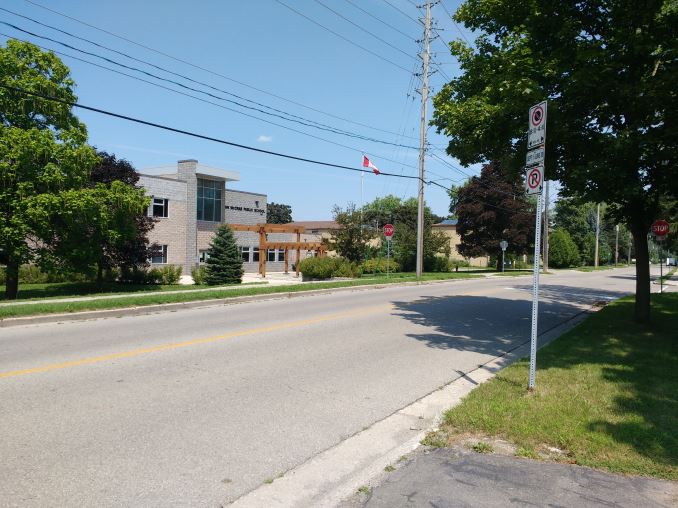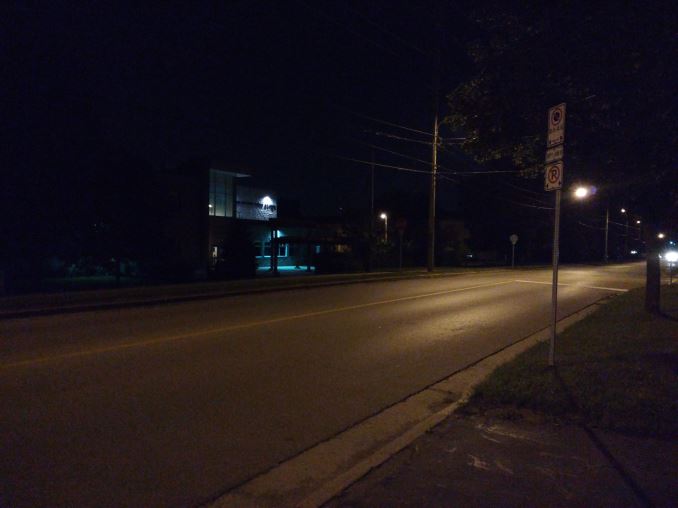The Moto G (2015) Review
by Brandon Chester on August 19, 2015 8:00 AM EST- Posted in
- Smartphones
- Mobile
Camera
One of the most notable improvements to the 2015 Moto G is its new rear-facing camera. The 2014 Moto G used Sony's IMX179, while the 2015 model adopts IMX214. The sensor size increases from 1/3.2" to 1/3.06" and the resolution increases from 8MP to 13MP. The aperture is also much wider, moving from F/2.4 to F/2.0, which can help offset the lower sensitivity of the smaller pixels. An overview of the Moto G's cameras can be found in the chart below.
| Camera Specifications | |||
| Moto G (2015) | |||
| Front Camera | 5MP (2560x1920) |
||
| Front Camera - Sensor | S5K5E2 (1.12 µm, 1/5") |
||
| Front Camera - Max Aperture | F/2.2 | ||
| Rear Camera | 13.0MP (4224x3400) |
||
| Rear Camera - Sensor | Sony IMX214 (1.12 µm, 1/3.06") |
||
| Rear Camera - Focal Length | 3.6mm (26mm eff) | ||
| Rear Camera - Max Aperture | F/2.0 | ||
While the Moto G lacks the voice coil motor from the Nexus 6 which is needed to enable OIS, the rest of the camera stack is effectively identical. The one difference on paper is the Moto G's shorter focal length which will give images a wider field of view.
Coincidentally, the move from IMX179 to IMX214 is the exact same change made between the Nexus 5 and Nexus 6. Whatever differences there are between the image quality of the 2015 Moto G and the Nexus 6 in good lighting rests primarily in the hands of their image signal processors. The Nexus 6 will obviously have a low light advantage due to its inclusion of OIS to lengthen shutter times, and we'll get to the low light differences after covering image quality with generous lighting.

In this daylight scene the Moto G performs very well. The exposure is very good, although I feel that it underexposed slightly while the Nexus 6 overexposed slightly. The Nexus 6 definitely has an edge when it comes to the sharpness of grass and foliage, as well as the preservation of textures such as the walls of the building and the pavement of the road. It's also worth noting that there's some lens distortion occurring on the Moto G which is causing color fringing along the white edges of the building windows, although at a normal viewing size it's barely noticeable. I think the Nexus 6 took an overall better photo, but only slightly better, with the Moto G doing a better job than any other mid-range device I've tested during the day.

Low light image quality is where things start to fall apart on the Moto G. While it's difficult to see in the small preview above, looking at the full size image reveals a great deal of color noise throughout the entire image, which doesn't exist on the Nexus 6. The Moto G took a 1/15s exposure, while the Nexus 6 was longer at 1/12s. 1/12s actually isn't very long for a device with OIS, and the difference in ISO value was not very large between the two devices either which means that Motorola's lacking quality has more to do with a simple lack of chroma noise reduction more than anything else. Chroma noise is by far the most distracting type of artifact in photos, and unfortunately it makes the Moto G unsuitable for photography in low light.
Video Quality
Video recording is a great test of a device's ISP as there's only a very short timespan to do processing on each frame that is captured. Since the 2015 Moto G and the Nexus 6 use the same image sensor this allows us to take a look at the differences in video quality between the ISPs in Snapdragon 410 and Snapdragon 805.
The Moto G records 1080p video at 30fps. Video is encoded with an average bitrate of 17Mbps using the H.264 high profile. For this comparison I limited the Nexus 6 to 1080p rather than UHD recording to make it an apples to apples comparison.
The most obvious advantage the Nexus 6 has is the stability of the video. While one might think this is due to the inclusion of OIS, the Nexus 6 isn't using the OIS for stabilization, and this is really just a case of superior EIS enabled by the superior ISP. As for the video quality itself, it's clear that the Nexus 6 is sharper across the frame and has greater detail on the various types of foliage in the area. The Nexus 6 also manages a better exposure, with the Moto G's video being too dark, with muted and just generally inaccurate colors. It appears that like the low light photo scene, the Moto G's video recording abilities are hampered by its ISP.
WiFi Performance
Like almost all of the low end and mid range devices I've tested recently, the Moto G ships with support for 802.11n on the 2.4GHz band. This single spatial stream implementation has a max link speed of 72Mbps.

The Moto G's WiFi speed is roughly the same as all other mid range devices. The Zenfone 2 is once again an exception to the rule, but I don't think anyone buying a device like the Moto G will have adopted an 802.11ac router at this point anyway due to cost reasons. I really hope we start seeing 5GHz support in mid range 802.11n phones though, rather than the ever increasingly crowded 2.4GHz band.






















90 Comments
View All Comments
3DoubleD - Wednesday, August 19, 2015 - link
Thanks for the response!1. The 5W charging time would be great! Thanks for adding that.
2. I agree, it is too bad they are hamstringing the GPUs in these devices. Three generations of Moto G including the same GPU is pretty disappointing. It seems Motorola is keeping customers interested in AAA gaming on their more expensive phones, which is understandable. From what you are saying, it sounds like the poor display calibration and poor visibility in sunlight would be more apparent to non-gamers than the GPU.
3. What I'm referring to is your comments in the concluding remarks: "The waterproofing is definitely a neat addition, but I think in most cases it's just a nice thing to have rather than a selling point. Once waterproofing is accompanied by the ability to use the display when it's really wet I'll be a lot more interested in it." I suspect many people will see waterproofing as a selling point (AKA a desirable feature) just from a pure ruggedness standpoint. Instances where people are deciding between several mid-range Android phones and pick the Moto G based on it being waterproof are probably more likely than decisions based on many of the other specs.
4. My problem with device thinness is that the benefit of thinner and thinner devices is dubious, yet the benefit for keeping the same thickness, or even increasing it, is substantial. I don't think a objective argument can be made for why a 6.9 mm phone is better than a 8 mm phone or even an 11.6 mm phone (like the Moto G). Even the subjective 'design' argument is pretty shaky, considering everyone was swooning over smartphone designs that first made it to 10 or 11 mm.
So as leading reviewer of phones and a spokesperson for the masses, I'd challenge you to develop a metric for phone thickness that equally considers 'thin design' with ease of use and battery life. IMO manufacturers hit the thin-enough-to-be-usable limit years ago. Let's stop praising thinness-at-all-costs in reviews (as is typical in a flagship Android or iPhone review) and start making a big deal when the design needlessly sacrifices battery life for thinness.
djc208 - Wednesday, August 19, 2015 - link
Seems to me the one major category that is missed between those two phones is support. More and more I'm just as interested in how it will be supported, and I wonder how well the Zenphone will be supported against future OS updates. I'd tend to lean toward Motorola for long term support. LG brought be in with great hardware but turned me off with crappy software support.Moto1 - Wednesday, August 19, 2015 - link
Zero support from Motorola. Emailed and called and all I get is generic replys-not related to my question. I bought the first moto g in anticipation of fast updates and have had zero-which sucks cause I was promised 5.0 over a year ago.Machete - Thursday, August 20, 2015 - link
False, we have a 1g Moto G in family and it was updated to 5.0 months ago.tipoo - Sunday, August 23, 2015 - link
Must be your carriers fault. My first gen G has been rocking 5 for months.tipoo - Wednesday, August 19, 2015 - link
MicroSD and 2GB RAM were the two things I sorely missed in my first gen G, so this looks like a fair upgrade. Honestly, it's all the phone most people need. Even the weak GPU runs most modern Android games well. The RAM was always the bigger issue than the processing speed, and the minor bump to the latter will be a nice bonus.Now just bring Moto Maker for the G to Canada and take my money, Motorola!
YukaKun - Wednesday, August 19, 2015 - link
So... Is this better than my SGS2? Y know the CPU is better, but is the camera and GPU?I'm having a considerable loss in battery life as of late (from 3 days to just 2) and the S2 is still running anything I need it to (GMail, GMaps and other "light" stuff) with no hiccups. So in my mind, instead of getting a battery replacement, maybe jumping to the MotoG 2015 might be a good idea.
Cheers!
a1exh - Wednesday, August 19, 2015 - link
Battery replacements are soooo cheap for the SGS2 though. If it is still going and you're happy. The SGS2 camera was better than the MotoG 2013a1exh - Wednesday, August 19, 2015 - link
As a MotoG 2013 customer I wanted the 2015 to be great. But it isn't. So the Vodafone Smart Ultra 6 is looking like the PAYG phone to get in the UK only it is a bit bigmkozakewich - Wednesday, August 19, 2015 - link
Devices like this really highlight the need for colour correction on Android. If it can fill the full sRGB gamut, the only thing left is to tell it where to put the colours. There's no reason something like this shouldn't be able to pull a dE2000 of 1.I remember the review of the Stream 7. Since it ran Windows, they were able to run a correction suite on it, and it ended up with a really good score despite its inability to saturate the blues.